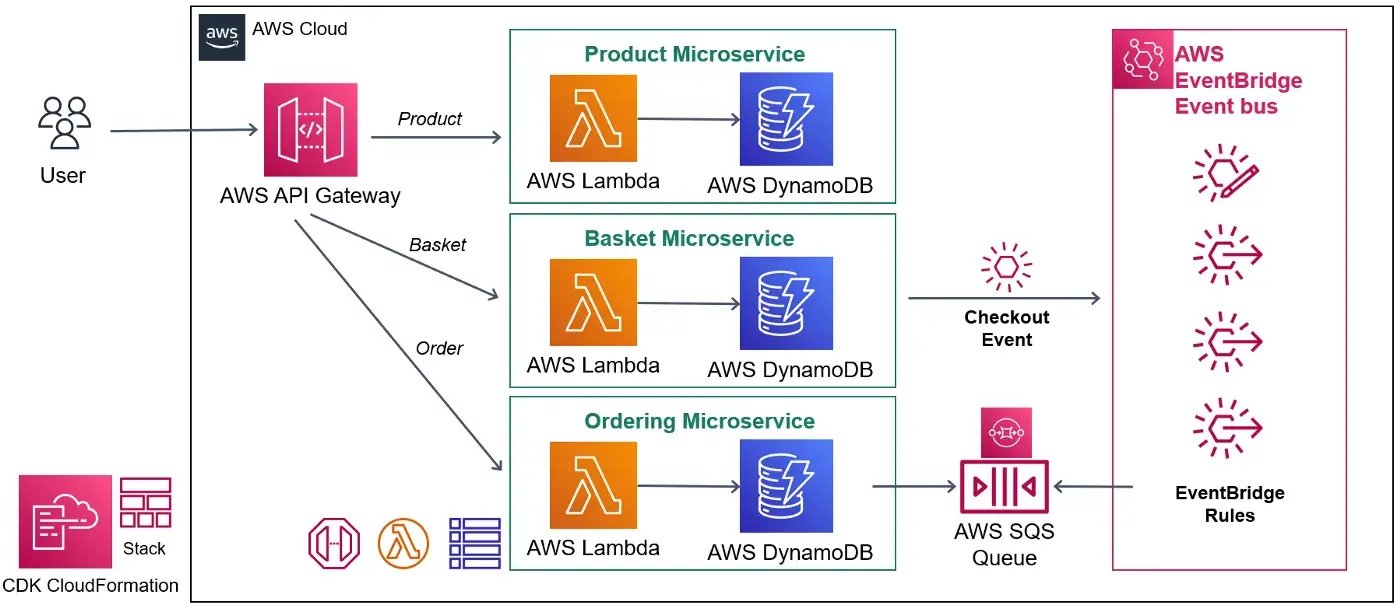As companies and the world become increasingly digital , many organisations — corporations or small businesses — are relying on cloud services to run their operations because the cloud is quick, effortless, affordable, and doesn’t require a huge upfront fee. There are many models for cloud adoption, and one of them is serverless, a model in which developers or organisations don’t handle any server and just focus on application logic. Serverless is ideal for running microservices, a framework in which applications are split into plenty of units that do very specific tasks that run separately; so if you’re authenticating to a new SaaS, that SaaS is probably using a microservice for that.
We’ll explain the characteristics, benefits, and challenges of serverless microservices by comparing them to traditional monolithic architectures and exploring real-world use cases. Solopreneurs and big companies alike will know when to use serverless microservices after reading this.
What is serverless?
Serverless computing is a cloud-based model for running applications without taking care of servers or server maintenance. It allows developers to avoid managing servers, hardware, infrastructure, middleware, or any other requirement a full-stack application has because the provider does it for them. In short, you are renting computing power and the whole platform management on a server that is maintained and managed by someone else. The main benefit of serverless computing is the cost and ease of use, you can launch your application without the need for an IT department.
Instead of provisioning, scaling, and maintaining infrastructure, developers focus solely on writing code. Cloud providers handle the underlying server management and automatically scale resources based on application demand. This pay-per-use model means users only pay for the actual processing time used.
The term “serverless” can give the wrong impression to a beginner; however, servers are still very much involved in a serverless architecture. But since the servers are out of sight and out of mind, we can say that applications are hosted in something else than servers (although that’s the case, strictly speaking).
What are serverless microservices?
A serverless microservice is best described as an independent part of an application that performs a specific task within the application but operates in its own environment and stores its own data. For example, you might have a web application through which you sell a product. When you sell a product, you need to manage that transaction. A simple way to do this would be by implementing a third-party component (microservice) that can easily plug into your application and manage and perform this task for you. Or, if you wanted, you could develop your own payment microservice—it’ll be just as easy to plug it in.
Developing and deploying web applications this way is scalable and easier than running a monolith because that small part—the microservice— of the app is contained within its own environment. It can be integrated into the rest of the application, but it can be maintained or switched out with relative ease.
A key characteristic of a microservice architecture is its independence. It should be deployable without affecting other parts of the application. Additionally, it should have well-defined boundaries and responsibilities. Serverless microservices maintain these core principles by being highly decoupled and cohesive (What this means: They operate on their own, but a set of microservices to do two different tasks are recognisable enough as part of a broader application). This means that while they communicate with each other through APIs, each microservice is responsible for storing, retrieving, and updating the data it needs to function independently.
❓What makes it serverless? The abstraction of infrastructure management makes it serverless.
🔌 What makes it a microservice? Loose coupling and high cohesion make it a microservice. This translates as: They don’t know about each other — loose coupling — but they work along well with each other — which is why they are in cohesion.
➕ So, what is a serverless microservice? A small, self-contained piece of code that works independently of other parts of the application and doesn’t require server management.
Monolith vs serverless microservice: What’s the difference between them?
A monolithic architecture is a software design where an entire application is built as a single, indivisible unit.
It is a tried and tested, classical approach to building apps. You define the features, you start writing them. And while this approach speeds up initial development and deployment, issues will inevitably crop up as the platform grows. As new features are added on top of the existing app, the codebase expands — and maybe there are plenty of teams working on that same app.
As the app gets larger, it becomes harder and harder for the team to understand the whole thing. Developers might know their own little part in the app functions, but it would require a massive effort to, let’s say, revamp the monolithic app as a whole or switch from one technology to another.
Tightly coupled components — as opposed to the “decoupled” components we mentioned before — mean changes to one part can impact the entire system. In a monolith architecture, developers are locked into the technology choices made at the start. This means that if better frameworks or programming languages come along, the team can’t easily switch to them.
Scalability is another issue. During peak seasons, like the holiday rush, demand for rental equipment can increase rapidly. A monolithic platform might struggle to handle this increased load, especially in key areas like payment processing. Deploying additional instances of the entire application is often the only solution, a time-consuming process that might be too slow to address the peak in time. By the time the new version is deployed, the peak demand might have very probably slowed down.

A serverless microservice architecture breaks the platform down into smaller, independently deployable services. Our photography equipment rental platform would consist of separate services for each of its components, that is, user management, inventory, recommendations, orders, payments, and reporting. Each of these services runs in its own container and communicates with others through APIs. Additionally, the “serverless” model eliminates the need to manage infrastructure entirely.

The serverless microservice model offers greater flexibility than a monolithic system. Teams can independently develop, deploy, and scale each service. They can accelerate development and improve their response to workload fluctuations because they’re better prepared for it. If payment processing in our rental app slows down during peak season, only the payment service — which in this case is an independent and cohesive component — needs to be scaled up. This means the bottleneck can be dealt with without affecting other parts of the application.
We will discuss the good and bad things about serverless microservices in the next sections. But first, let’s briefly describe an example of how serverless microservices architectures work.
How serverless microservices work: a quick example
An e-commerce platform can be a good example of how microservices help a shopper choose, check out and pay for their goods. When a customer adds a product to their cart, this action triggers an event within the serverless architecture. This event is then passed on to the right microservice, in this case, the shopping cart service.
In serverless, these microservices are just small, independent pieces of code called functions. They only snap into action when something specific happens, like a customer adding an item to their cart, a payment being processed, or a product running out of stock. Instead of running all the time, these apps only run when needed, which saves money on processing power. If the e-commerce platform only operates in one country with a single time zone, they’ll surely be cutting down on processing power during the wee hours (drunk shoppers who spend almost $50 billion a year are a good excuse to keep the site running all night long).
If a competitor wanted to start their site and launch a web application for selling items to drunk buyers, they could use pre-built microservices for features like user authentication or payment processing to get a head start. Some of these services can be found on platforms like Genezio . Genezio is a serverless platform for building applications, and it also offers pre-built, typesafe microservices.

In the past, setting up these services would involve a lot of technical work and managing servers. With serverless microservices, the platform provider handles all the behind-the-scenes details, like scaling and infrastructure.
How do solopreneurs, SaaS companies and IT talent benefit from serverless microservices?
Solopreneurs and IT workers who need to start their own projects fast can use microservices with very similar benefits. They’ll be able to launch fast, and their stack will exist independently of other platforms (i.e., by using Genezio, they won’t have to deploy on an already-existing legacy machine that the company forces them to use). The microservices’ architecture will mean they’ll be able to drop an MVP with the minimal features and then build upon that slowly.
Just like the e-commerce platform we were referring to, a solopreneur won’t have to care about scaling up when their app becomes a hit because the serverless design will do it for them. And, just like a SaaS business would benefit from, they won’t have to pay for server time when their app is idle.
Advantages of serverless microservices
We just named some practical advantages for a score of tech workers. Those are just a few. Serverless microservices offer even more benefits than might be found partly in a microservice architecture, partly in a serverless design, but only completely when combining both technologies.
1. Teams can work independently
Microservices are great for breaking down big projects into smaller, more manageable pieces. Teams can work independently on their own parts without getting in each other’s way. This helps prevent delays and keeps everyone focused.
Because each function works independently, if one part of them fails, the rest can keep going. This means that the whole app won’t crash as often.
2. Quicker development
Each part of the app can be built and tested separately, then be deployed and put live automatically. New features can be rolled out faster.
3. Automatic scaling
Serverless microservices can automatically adjust to handle different levels of demand. This means that when there’s a sudden increase in traffic, like during a sale, the system can quickly scale up to handle the load. When things quiet down, it automatically scales back to save costs.
4. Flexibility
Unlike monolithic architectures, where developers are constrained to the technology choices made at the initial stage (or made by an IT intern 20 years ago), in serverless microservices each part of the team can use different frameworks and programming languages. This gives developers more freedom to choose what works best for them.
5. Pre-built components
Serverless microservices let you easily combine different cloud services like databases, message queues, and object storage to build your app. This means you can reuse code and save time by leveraging pre-built solutions. Genezio offers plenty of pre-built components, including typesafe features, databases, auth, and cron jobs to build full-stack applications without building them from scratch.
6. Cost savings
We mentioned this one plenty of times, but we can’t understate it: With serverless microservices you only pay for the computer power you use, so it’s cheaper than buying a plan from a big cloud provider (and cheaper than filling a rack with on-prem servers).
Disadvantages of serverless microservices
There are a few downsides to serverless microservices to look out for:
1. Dealing with countless small parts
If you’ve got loads of tiny bits of code doing a different job at the same time, let’s say over 100 independent functions, it can be really painful and time-consuming keeping track, updating and deploying all of them.
2. Testing is tricky
Figuring out which tests to run and when to run them is tough. Some developers claim that sometimes testing across microservices can be harder than in a monolith architecture.
3. Cold starts (unless you plan ahead)
Serverless environments usually have to deal with latency and cold starts when code hasn’t been running for a while. The best way to counter this disadvantage is to partner up with a tech company that has developed a workaround to them. Genezio Functions , for example, are designed to prevent cold starts for any serverless app and starts up to 4x faster than AWS Lambda.
4. Low visibility
If you’re a first-timer, it can be hard to keep track of request flows, find dependencies, and find problem sources in serverless microservice architectures. Still, these challenges are largely avoidable as long as you have the right partner and understand why you’re trying microservices in the first place. Just about the same could be said of any other kind of architecture — including monoliths.
💡Many developers recommend starting slow. To get used to serverless microservices, you could try moving just one bit of your app to a single function first. Or, you could begin by moving the less important parts of your app to serverless microservice architecture and gradually add more as you go.
Start using serverless microservices now
Serverless microservices have become a fundamental tool in today’s developing environment, as they help build applications that are easier to manage and scale. This is why we encourage you to make a step forward and begin your journey into serverless microservices. Genezio is a strong starting point.
As a specialised serverless provider, Genezio easily guides businesses and developers in selecting the right serverless architecture for their current and future needs. With a true pay-as-you-go model and type-safe methods, our platform motivates developers to focus on innovation rather than infrastructure management. Sign up now to try the platform and start building your serverless application for free. You can get started in seconds!
To learn more about the advantages of typesafe serverless platforms with unlimited builds, visit Genezio .
Article contents
Subscribe to our newsletter
Genezio is a serverless platform for building full-stack web and mobile applications in a scalable and cost-efficient way.
Related articles
More from Learning
8 Top Express Hosting Platforms: Your Ultimate Guide to Deploying Your Web App with Ease
Luis Minvielle
Jul 03, 2024






